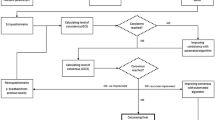Abstract
Background
Laparoscopic surgery requires fundamental skills peculiar to endoscopic procedures such as eye–hand coordination. Acquisition of such skills prior to performing actual surgery is highly desirable for favorable outcome. Virtual-reality simulators have been developed for both surgical training and assessment of performance. The aim of the current study is to show construct validity of a novel simulator, LapVR (Immersion Medical, San Jose, CA, USA), for Japanese surgeons and surgical residents.
Methods
Forty-four subjects were divided into the following three groups according to their experience in laparoscopic surgery: 14 residents (RE) with no experience in laparoscopic surgery, 14 junior surgeons (JR) with little experience, and 16 experienced surgeons (EX). All subjects executed “essential task 1” programmed in the LapVR, which consists of six tasks, resulting in automatic measurement of 100 parameters indicating various aspects of laparoscopic skills.
Results
Time required for each task tended to be inversely correlated with experience in laparoscopic surgery. For the peg transfer skill, statistically significant differences were observed between EX and RE in three parameters, including total time and average time taken to complete the procedure and path length for the nondominant hand. For the cutting skill, similar differences were observed between EX and RE in total time, number of unsuccessful cutting attempts, and path length for the nondominant hand. According to the programmed comprehensive evaluation, performance in terms of successful completion of the task and actual experience of the participants in laparoscopic surgery correlated significantly for the peg transfer (P = 0.007) and cutting skills (P = 0.026).
Conclusions
The peg transfer and cutting skills could best distinguish between EX and RE. This study is the first to provide evidence that LapVR has construct validity to discriminate between novice and experienced laparoscopic surgeons.


Similar content being viewed by others
References
Zhang A, Hunerbein M, Dai Y, Schlag PM, Beller S (2008) Construct validity testing of a laparoscopic surgery simulator (Lap Mentor) (2008) evaluation of surgical skill with a virtual laparoscopic training simulator. Surg Endosc 22:1440–1444
van Dongen KW, Tournoij E, van der Zee DC, Schijven MP, Broeders I (2007) Construct validity of the LapSim: can the LapSim virtual reality simulator distinguish between novices and experts? Surg Endosc 21:1413–1417
Eriksen JR, Grantcharov T (2005) Objective assessment of laparoscopic skills using a virtual reality stimulator. Surg Endosc 19:1216–1219
Yamaguchi S, Konishi K, Yasunaga T, Yoshida D, Kinjo N, Kobayashi K, Ieiri S, Okazaki K, Nakashima H, Tanoue K, Maehara Y, Hashizume M (2007) Construct validity for eye-hand coordination skill on a virtual reality laparoscopic surgical simulator. Surg Endosc 21:2253–2257
McDougall EM, Corica FA, Boker JR, Sala LG, Stoliar G, Borin JF, Chu FT, Clayman RV (2006) Construct validity testing of a laparoscopic surgical simulator. J Am Coll Surg 202:779–787
Carter FJ, Schijven MP, Aggarwal R, Grantcharov T, Francis NK, Hanna GB, Jakimowicz JJ (2005) Consensus guidelines for validation of virtual reality surgical simulators. Surg Endosc 19:1523–1532
Satava RM (1993) Virtual reality surgical simulator. The first steps. Surg Endosc 7:203–205
Reznick RK, MacRae H (2006) Medical education—teaching surgical skills—changes in the wind. N Engl J Med 355:2664–2669
Gallagher AG, Ritter EM, Champion H, Higgins G, Fried MP, Moses G, Smith CD, Satava RM (2005) Virtual reality simulation for the operating room—proficiency-based training as a paradigm shift in surgical skills training. Ann Surg 241:364–372
Kundhal PS, Grantcharov TP (2009) Psychomotor performance measured in a virtual environment correlates with technical skills in the operating room. Surg Endosc 23:645–649
Seymour NE, Gallagher AG, Roman SA, O’Brien MK, Bansal VK, Andersen DK, Satava RM (2002) Virtual reality training improves operating room performance—results of a randomized, double-blinded study. Ann Surg 236:458–464
Aggarwal R, Ward J, Balasundaram I, Sains P, Athanasiou T, Darzi A (2007) Proving the effectiveness of virtual reality simulation for training in laparoscopic surgery. Ann Surg 246:771–779
Grantcharov TP, Kristiansen VB, Bendix J, Bardram L, Rosenberg J, Funch-Jensen P (2004) Randomized clinical trial of virtual reality simulation for laparoscopic skills training. Br J Surg 91:146–150
Sturm LP, Windsor JA, Cosman PH, Cregan P, Hewett PJ, Maddern GJ (2008) A systematic review of skills transfer after surgical simulation training. Ann Surg 248:166–179
Schijven M, Jakimowicz J (2003) Construct validity—experts and novices performing on the Xitact LS500 laparoscopy simulator. Surg Endosc 17:803–810
Duffy AJ, Hogle NJ, McCarthy H, Lew JI, Egan A, Christos P, Fowler DL (2005) Construct validity for the LAPSIM laparoscopic surgical simulator. Surg Endosc 19:401–405
Woodrum DT, Andreatta PB, Yellamanchilli RK, Feryus L, Gauger PG, Minter RM (2006) Construct validity of the LapSim laparoscopic surgical simulator. Am J Surg 191:28–32
Sherman V, Feldman LS, Stanbridge D, Kazmi R, Fried GM (2005) Assessing the learning curve for the acquisition of laparoscopic skills on a virtual reality simulator. Surg Endosc 19:678–682
Pellen MGC, Horgan LF, Barton JR, Attwood SE (2009) Construct validity of the ProMIS laparoscopic simulator. Surg Endosc 23:130–139
Andreatta PB, Woodrum DT, Birkmeyer JD, Yellamanchilli RK, Doherty GM, Gauger PG, Minter RM (2006) Laparoscopic skills are improved with LapMentor (TM) training—results of a randomized, double-blinded study. Ann Surg 243:854–863
Acknowledgements
The author would like to thank all participants for their engagement in this study.
Disclosures
Authors Naoki Iwata, Michitaka Fujiwara, Yasuhiro Kodera, Chie Tanaka, Norifumi Ohashi, Goro Nakayama, Masahiko Koike, and Akimasa Nakao have no conflicts of interest or financial ties to disclose.
Author information
Authors and Affiliations
Corresponding author
Rights and permissions
About this article
Cite this article
Iwata, N., Fujiwara, M., Kodera, Y. et al. Construct validity of the LapVR virtual-reality surgical simulator. Surg Endosc 25, 423–428 (2011). https://doi.org/10.1007/s00464-010-1184-x
Received:
Accepted:
Published:
Issue Date:
DOI: https://doi.org/10.1007/s00464-010-1184-x




